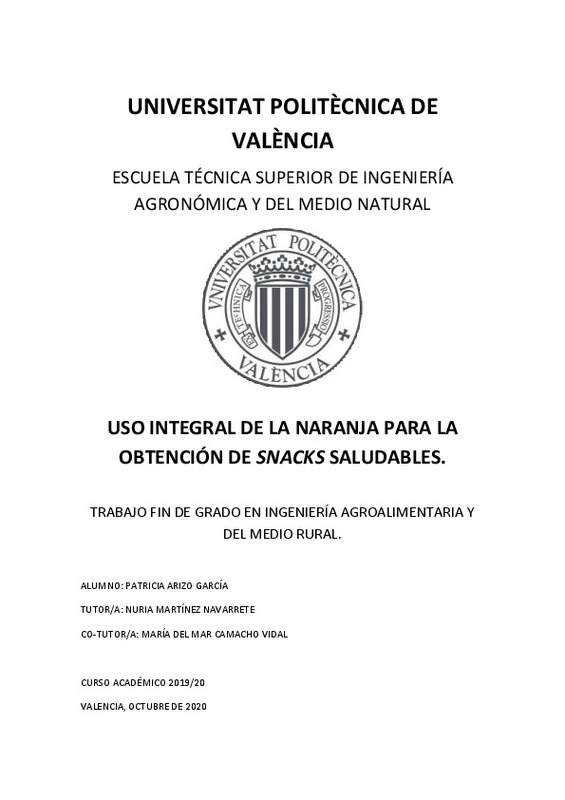|
Resumen:
|
[ES] A pesar de que la fruta tiene claros efectos positivos sobre la salud, en la actualidad, su consumo se ve limitado por diferentes motivos, entre ellos la falta de practicidad para su ...[+]
[ES] A pesar de que la fruta tiene claros efectos positivos sobre la salud, en la actualidad, su consumo se ve limitado por diferentes motivos, entre ellos la falta de practicidad para su ingesta. Ante esta problemática, la administración trata de promover el consumo de fruta, lo que necesariamente ha de ir ligado a la actividad de I+D+i de la industria agroalimentaria. En los últimos tiempos, lo que se ha venido en llamar la snackificación, está generando nuevas oportunidades de mercado para la comida tradicional ofertada en modo snack. Desde este punto de vista, los snacks de fruta se muestran como una oferta de alimento saludable y cómoda de consumir. No obstante, la industria también se enfrenta al reto de la gestión de los subproductos que genera. En el caso de las frutas en general y, de la naranja, en particular, la obtención de un snack, a partir de, por ejemplo, el puré de ésta, supone generar una gran cantidad de corteza. Sin embargo, dado que esta corteza es también una fuente importante de fibra y otros compuestos bioactivos, puede resultar interesante integrar esta biomasa en las líneas de producción. En este trabajo pretende planificar un estudio que permita conocer la viabilidad del uso del co-producto del puré de naranja liofilizado en polvo en la formulación de un snack, además de proponer la metodología para llevarlo a cabo. La hipótesis de partida es que la presencia de polisacáridos de alto peso molecular en el exocarpio del fruto pueda contribuir, bien a nivel estérico o bien aumentando la temperatura de transición vítrea (Tg) del producto, a minimizar los problemas de colapso estructural que presentan los productos de fruta deshidratada. Para ello, en primer lugar, es necesario conocer sus relaciones Tg-humedad-actividad del agua. Por otra parte, habrá que diseñar una serie de formulaciones del snack de las que habrá que conocer, no sólo sus propiedades, sino también su estabilidad. Para el diseño de estas formulaciones habrá que tener en cuenta la composición de las diferentes partes de la naranja. Con esta información, la corteza en polvo, sola o combinada con otros biopolímeros compatibles, de uso habitual en la industria de alimentos, podrá añadirse en diferentes proporciones al puré de naranja antes de su deshidratación. Habrá que seleccionar las propiedades de interés a analizar a los diferentes snacks formulados, proponer la metodología para su medida y diseñar un estudio de almacenamiento que permita conocer la viabilidad del uso del co-producto en la formulación del snack. El trabajo se ha completado, a nivel experimental, con algunos de los ensayos propuestos.
[-]
[EN] Although fruit has clearly positive effects in human health, currently, fruit consumption has decreased for different reasons; one of them is the lack of practicality that supposes his consumption. Being aware of this ...[+]
[EN] Although fruit has clearly positive effects in human health, currently, fruit consumption has decreased for different reasons; one of them is the lack of practicality that supposes his consumption. Being aware of this problem, the Administration is trying to promote fruits consumption, this promotion is necessarily linked to I+D+I activity of food industry. In recent times, snacks production process, has been producing new market opportunities for traditional food that has been offered as snacks. From this point of view, fruits snacks are showed as a healthy and convenient food supply. However, industry also faces the challenge of managing the by-products generated. In the case of fruits, particularly the orange, obtaining a snack from, par example, orange puree supposes the generation of a large amount of orange peel. However, knowing that orange peel is also an important source of fiber and other bioactive compounds, incorporating this biomass to the production lines could by an interesting possibility. This work aims to plan a study that would allow us to know the viability of using the freeze-dried powdered orange co-product in a snack formulation, in addition, this work propose a working methodology. The initial hypothesis says that the presence of high molecular weight polysaccharides in the exocarp of the fruit can contribute, either at the steric level or by increasing the vitreous transition temperature (Tg) of the product, to minimize the problems of structural collapse presented at dehydrated fruit products. To do this, in the first place, it will be necessary to know their Tg-humidity-water activity relationships. On the other hand, it will be necessary to design a series of snack formulations of which we will have to know, not only their properties, but also their stability. For the design of these formulations, the composition of the different parts of the orange must be considered. With this information, the powdered peel, alone or mixed with other compatible biopolymers, commonly used in food industry, can be added to orange puree before dehydration. It will be necessary to select the properties of interest to analyze at the different formulated snacks, propose the measurement methodology and design a storage study that allows to known the viability of using the co-product in the snack formulation. The work has been completed, on an experimental level, with some of the proposed trials.
[-]
|







